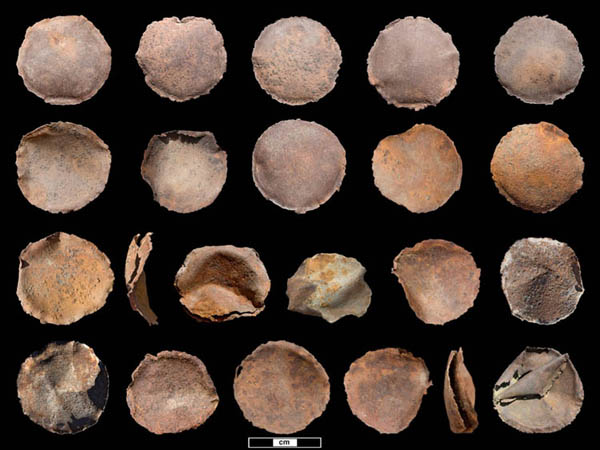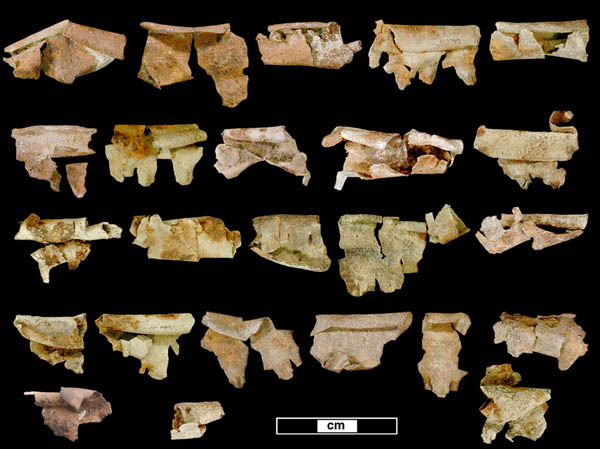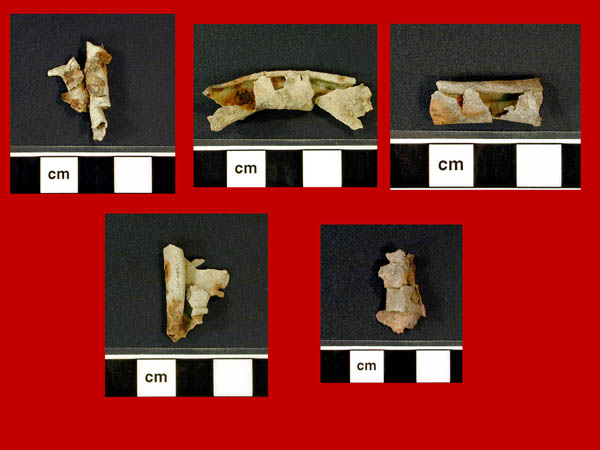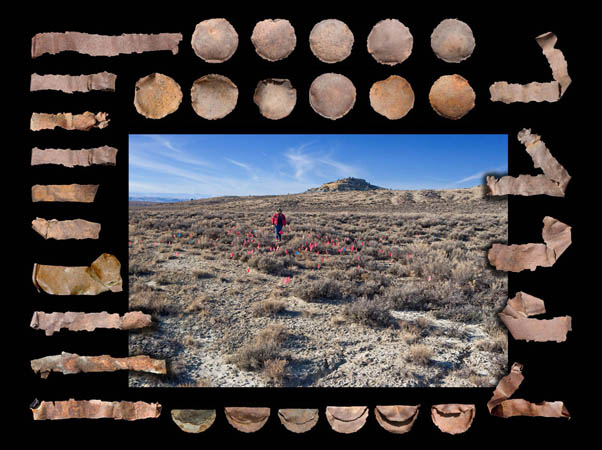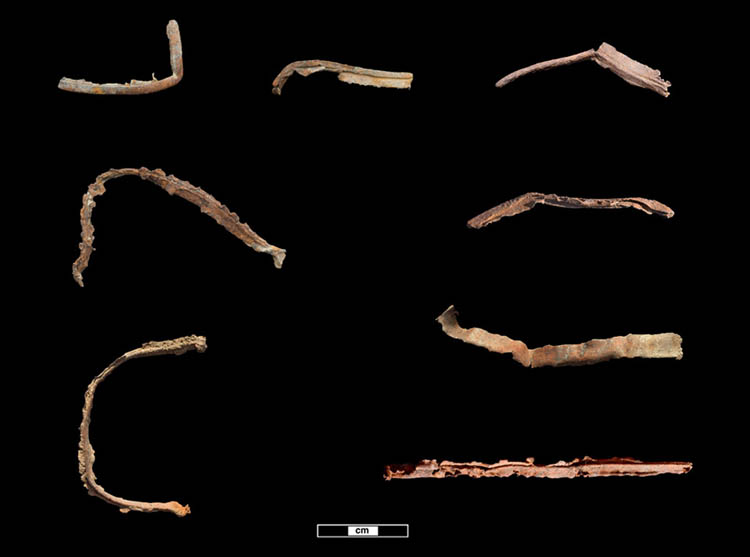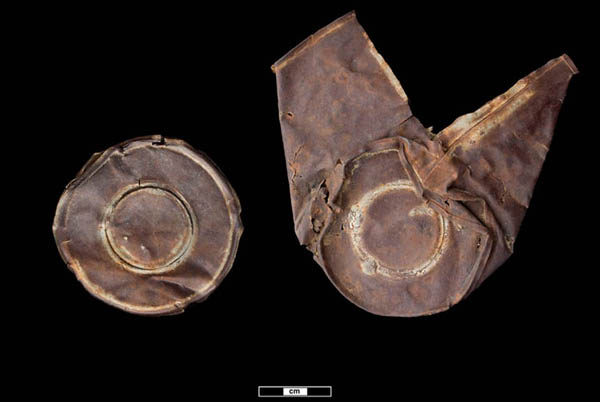The following possible theories have been proposedto explain strips and disk sites. We considered the pros and cons of each, and our ideas are presented below. The evidence at this time supports Indian manufacture of items such as tinklers.
Explanation: Strips and discs are discard byproducts from tinkler and concho manufacture(our presently preferred explanation). We find most plausible that strips and discs are attributable to Historic Period Indians and might represent manufacture of tinklers or similarly constructed tin beads from the strips, and conchos from the discs.
Pros. Ethnohistorical sources abound with references of Indians throughout northeastern Wyoming between 1850 and 1880 (e.g., Murphy 1928; Weist and Sharrock 1985). Although sources (e.g., Larson 1979:28, Weist and Sharrock 1985:1) indicate that Indians on the Northwestern Plains were living on reservations by 1880, this does not mean that they never left those areas. Kinds of Indian camps in the region during the late 1800s and early 1900s are shown in historic photographs, such as one in the Denver Public Library, Photography Collection (Call Number X-32362) of an Arapaho camp near Casper Wyoming (Figure 3). The photo, taken between 1880 and 1910 along the Oregon Trail, shows three tipis (painted with figures of shields, and humans on horses) and a covered wagon. Other photographs in that collection show a Crow village in the Bighorn Forest taken between 1870 and 1900 with tipis, horses, and carriages (Call Number X-31279). These photos show that the old ways of the tribes in this region were being changed by Euroamericans, and the presence of tipis in conjunction with what is commonly classified as a sheepwagon attest to the fact that sites with tin cans cannot be categorically dissociated with Native Americans.
Tinklers are shown in archival photographs, were pictured by early travelers on the northwestern Plains, are found in archeological sites, are on display in numerous museums, and are present in local artifact collections. Metal tinkers were made from a pie-shaped or wedge-shaped piece to produce a conical form, small at the upper end and more open at the lower, manufactured by wrapping the cut piece around a small metal awl. The completed conical pieces, usually about 3/4 to 1 inch long, are suspended from a shoe, shirt, or other garment. Finely made tinklers were generally obtained through trade, as Hoebel noted in his ethnography of the Cheyenne:
Old-type moccasins are … adorned with porcupine-quill or trade bead embroidery done in geometric patterns, or with little cone-shaped tinklers of tin, obtained from the white traders (Hoebel 1960:63).
Items at sites 48CA3445 and 48CA3450 are the most suggestive of finished tinklers, and some may have been suspended or strung horizontally. Examples at these two sites appear to be curled or rolled on one side-end (Figure 12), essentially identical to a typical tinkler, but with the other side-end of the strip cut with one to four tabs. The tabs could have been used to attach the tinkler to a garment, allowing the horizontally rolled piece to dangle; or (more likely) the tinkler could have been strung (or sewn) to a garment horizontally, allowing the tabs to dangle downward. It may be that the remains at these two sites contain more finished or nearly finished artifacts than other sites with a higher percentage of discarded materials and byproducts. The 1.5” discs at all sites could have been used as conchos as their size and shape are consistent with those observed in photographs and in museum collections. One at site 48CA4455 has a hole on one side as if perforated for attaching to a garment. Tinklers and conchos made of strips and discs might not be as high quality as those seen in posed photographs of people wearing clothes adorned with such artifacts, or tinklers displayed in museums. It is likely that ordinary people, especially by the late 1800s when tribes were at war with the U.S. military, and people were being forcibly moved to reservations and did not have access to money or goods, would resort to using pieces of tin cans for the manufacture of such items that were important to their lifestyle. Support for use of tin cans for tinklers and conchos can be seen in literature regarding tinklers on dresses used in the Jingle Dance, a late development on the Plains. The dance originated with the Ojibwa in the late 1800s for healing but quickly spread across the Plains all the way to the Navajo (Sexsmith 2001, Spirit Bear 2004, Trimble 2004, Wild West 2003). This woman’s dance, done in a dress with rows of tin cones, reached the Crow of the Powder River Basin relatively late (Medicine Crow 2004), and is still popular at the annual Crow Fair (Graetz 2000, Intrepid Traveler 1998). The early 1900s versions of the dresses had tin cones made from the lids of snuff cans (Kidwell 1996, Wild West 2003, Medicine Crow 2004), and today some continue to be made from the lids of chewing tobacco cans (Graetz 2000, Intrepid Traveler 1998, Kidwell 1996, Trimble 2004). This suggests that there was a precedent for use of tin can pieces as tinklers.
The Encyclopedia of North American Indians notes that with the coming of Europeans dance regalia evolved, with metal rattles and bells replacing those formerly made of natural materials as shells, teeth, and deer hoofs. Specifically they note, “Tin-can leg rattles, for example, have substituted for rattles made from turtle shells” (Heth 1992:1).
During the mid eighteenth century, at the Gilbert Site in east Texas discarded brass kettles with extensive wear were found to have been cut up to create tinkler cones (Blaine 2001:4). Such reuse of available metal was fairly common during early historic times.
Cons. There are no complete unquestionable tinklers or conchos present in the Wyoming sites. This could be because the sites are areas of discard where rejects or unused materials were left.
Explanation: Strips and discs are common sheepherder debris (preferred by most doubters of the tinkler theory). The materials remaining here are normal debris left by camping sheepherders. This is the explanation consistently stressed by BLM and is most commonly suggested by other people when first confronted with the assemblage from strips-and-discs sites.
Pros. The Powder River Basin contains hundreds of sites with early to late tin cans and usually other debris. Some of these sites are known to be sheepherder camps, and some contain the remains of burned sheep wagons presumed to have been associated with herders. These sites are evidenced primarily by discarded tin cans.
Cons. Within the Powder River Basin there are hundreds of recorded historic camps evidenced by complete and partial tin cans. There are, however, no positively identified sheepherder camps with tin cans that also contain strips and discs. In presumed herder camps where cans are fragmented, they occur in random shapes and sizes and not in relatively uniform strips and 1.5 inch discs. If strips-and-discs sites were to represent herder remains, they would be exceedingly unusual within that site type and would necessitate intensive study to determine what their unusual function would be within the overall historic system. Their unique assemblage, however, argues against any such relation. A search of the Wyoming SHPO Records database (7/23/04) indicates that there are 322 sites in Campbell County and 78 sites in Converse County coded as Ranching—Stockherdering, and only 14 in both counties coded as strips and discs, indicating the rareness of the artifact assemblage. However, assigning strips-and-discs sites the function of herder debris is not an explanation for the artifacts nor does it attempt to explain the time and effort that went into their preparation. Indeed, such an explanation seems unlikely within the overall system of herder site assemblages.
Throughout the northwestern Plains, herders with time on their hands were known to build rock cairns, collect arrowheads and other Indian artifacts, and even flake plate glass. There is, however, no documentation or known oral tradition that they cut metal into strips and discs.
Additionally, it is not possible even to identify most historic trash sites (regardless of the condition of the cans) definitely as sheepherder camps, although this generic identification has become accepted within the local archeological and management community and even expected as the functional explanation for such artifact assemblages. It is known from historical records that such discarded trash remains are consistent with camps associated with other people — U.S. Army, Anglo trappers, old and modern hunters, ranch range riders, fence repair crews, small Indian groups, travelers, and any number of different kinds and affiliations of persons at any place, at any given time, anywhere within the Powder River Basin and beyond. Therefore, even the term sheepherder camp — within the context of present archeological surveys and syntheses — is a meaningless concept and without good, limiting foundation. The term, applied to almost any kind of historic trash, usually without associated structural remains, serves only to allow unjustified categorization of remains and similarly unsupported management decisions. While relatively recent remains are likely associated with herders, other ranch workers, or modern hunters, older remains dating from the 1800s are less certainly identifiable to affiliation or function. There has been no study of different kinds of early historic sites and no linking of different kinds of sites into any of a number of different systems. Likewise, there is no shown relation of strips-and-disc sites with any other historic site types also containing hole-in-top cans. The absence of other kinds of historic artifacts, common on other kinds of early historic sites, suggests that the site types are not related and instead represent different affiliations and functions.
Explanation: Strips and discs were tied to a temporary fence around a lambing area to warn the sheepherder of approaching predators. The BLM proposed this explanation, based on hear-say suggestion but without a source. We have talked with numerous herders and ranchers (and at one point in our lives spent years working with sheep) but have never heard such a process even insinuated.
Pros. None.
Cons. The system would not work, and there is no documented support or analogous model that items such as these were attached to a temporary fence around a lambing area to warn the herder of approaching predators. The small pieces would not make enough noise and could not function properly for such an intention. There also is no evidence that the metal pieces were actually suspended. If the strips had been tied together to make enough noise to warn predators, we would expect to see evidence on remaining artifacts, which we do not observe. Mostly there would be no reasonable way to attach or string discs as they have no perforation. If wire or string were threaded through the strips, or wrapped around them, there should still be at least some indication on some of the 2000 items inventoried to date. A few could have delicately attached to clothing, but there is no indication that anything was tied to them. The pieces (especially trimmed seam fragments) are obviously discarded byproducts, and we still do not know what the missing parts — the ends — might have been used for.
Complete cans would have been more effective, would have resulted in a louder noise, and would have been less time consuming to string. The noise created by even hundreds of small strips and discs together could not produce near the volume that could be created by using entire cans. Complete cans were tied together to create bells to hang around the necks of sheep and cows, and several such necklaces have been found throughout the Powder River Basin.
Similar use of whole tin cans — not pieces — was recorded for Indians. An article in the Kansas Collection Books noted use by Sioux in the late 1800s:
Burials took place in the day, and at night grand dances were held. Indians on the opposite side of the river were invited to participate. Tin cans, which had been collected and taken to the tepees, served as musical instruments. The noise and confusion were sometimes deafening, dances being kept up almost continuously (De Voe 1904:7).
Explanation: Sheepherders used the cans filled with fireworks as bombs to scare predators, and when the can exploded it shredded into strips and discs. The BLM proposed this explanation from a landowner who had been told by a local old-timer (Loren Coslett, now deceased) of using fireworks in tin cans to scare predators, particularly coyotes.
Pros. Observed materials consist of can fragments.
Cons. The suggestion that strips and discs were not cut but instead were created by an explosive force from fireworks within the can is not supported by physical characteristics of the artifacts. There is no evidence on any site that cans were blown out and fragmented from explosive force. Such force would have produced radically different fragmentation from that which is exclusively represented at the sites. An explosion of that magnitude would rip a tin can to pieces and would not form uniform strips and 1.5 inch diameter discs. Observed strip pieces are cut, and discs stamped, not separated by explosion. Exploded cans would not have the end seams evenly trimmed. Exploded cans would include end fragments, which are absent on these sites. Additionally, there would be more remnants of the soldered portion of the can ends, perforated ring seal discs, and at least some pieces of intact lateral seams. An explosion would not uniformly strip a can around its circumference, with no lengthwise pieces, and all parts of the can — of various sizes and shapes — would be represented.
Fireworks in tin cans would not scare predators any more than fireworks alone, and certainly much less than shots from a rifle — which all herders carried at all times and used quite effectively. Much more likely would be that fireworks would be set off in tin cans (or bottles) sealed as well as possible (e.g., with wood or mud) just to watch them explode, much like shooting filled tin cans or bottles with a rifle.
Explanation: The tin pieces are fragments of chaff from WWII era aircraft. The items could be left over from aerial target and bombing practice from the 1940s (BLM suggestion).
Pros. Aircraft practiced in east-central Wyoming during the 1940s and left behind metal fragments from those activities.
Cons: Metal fragments from 1940s WWII training activities are limited almost exclusively to 50 caliber machine gun casings, bullets, whole cartridges, and cartridge chains. Such remains do not include hole-in-top can pieces that date from the middle to late 1800s. Aerial gunnery ranges were in specific areas north of Glenrock (Converse County) and west of Casper (Natrona County). No strips-and-discs sites are yet known within those areas.
Explanation: Strips and discs are remnants of horse equipment. Metal items were used to make, repair, and decorate horse equipment by both Plains Indians and Euroamericans.
Pros. People in the area during the time of the strips and discs were using horses. Indian horses were known to be decorated with “distinctive painting, bead or quillwork, fringe, brass tacks, trade cloth, or metal bells and tinklers” (Hansen 1994).
Cons. There are no pieces of leather or animal tack that would indicate that the strips and discs were being used for repair or decoration of saddles, items associated with harnesses, or other tack, riding gear, or wagon parts. None of the strips is perforated for such use, and none is shaped in any way to suggest use as a decorative element or attachment other than possibly a tinkler or concho, which were known to be used for decoration on horses as well as people.
Explanation: Strips and discs are remnants of knife, scraper, or arrowpoint manufacture. Cast-off metal was used by Plains Indians to make tools.
Pros. Metal was scarce in the region, and it would be reasonable for any metal, such as tin cans, to have been used for local manufacturing, especially within the realm of making use of available resources. There are reports of Navajo using tin cans to make homemade knives in the late 1800s (Benally 2004), and metal hide scraper bits are in the Finnell collection from the Summit Springs battlefield in northeast Colorado (Reher 2003).
Cons. The disc shape and sizes do not lend themselves to knives, scrapers, or arrowheads. Although strips could have been used for any such purpose, there are no items that suggest any such alteration or resemble either unfinished or final products. It could be that the rough-edged strips (sometimes saw-like) were intended or used as expedient knives or scrapers, but again there are no indications of intentional modification, no sharpening, and no evidence of use.
Explanation: Pieces were used as knives and scrapers for processing animals.During the killing and processing of hogs (about 1948), cut-out can ends were used for scraping the hair from hides (Osborn 2001).
Pros. None.
Cons. This would have resulted in observable rounded edges, which are not present in the sample of observed archeological can pieces.
Explanation: Pieces were intended as raw material for manufacture of decorative pieces. Tin cans were cut up into pieces, and the polished tin was used to make utensils and decorative pieces.
Pros. One source (Museum of New Mexico 2004) mentions that when the Army in New Mexico began to discard food cans in the middle 1800s, local workers would use the metal for decorative cut-outs and other kinds of production. Another source (Juniper Learning 1998) comments that by 1846 people in New Mexico were acquiring (mostly purchasing) old Army cans for manufacture of such items as mirrors, crosses, and candle holders. The tradition continues to this day in Mexico and the Southwest.
Cons. Except for the cut body strips and the missing ends, there is no indication that the Wyoming can pieces were being used to produce any other shapes, were being used in manufacture of composite objects, or were being polished or otherwise modified.
Explanation: Pieces are the remains of canon firings, presumably from the U.S. Army during the middle to late 1800s.A discussion of early Army forays into the Black Hills in search of gold includes the following:
When the Montana contingent of miners left Montana for the Black hills in the '70's, Indians were troublesome in the region through which they must pass, Fort Ellis gave them a small cannon and suitable ammunition, and John Bozeman, who was of the party, took with him says Cook, "an iron piece of four-inch caliber. We had to make ammunition for this piece. We got some blue flannel and made sacks to fit the muzzle, and about ten inches long to hold the powder, and for shells we went to the tin shop and had cans made to fit the bore of the gun. For projectiles we went to the blacksmith shop and got all the old scraps of iron horseshoes and cut them up to fill the cans. I want to record that when we fired this gun, the cans burst when they left the muzzle of the gun, the pieces of iron not being of the same shape or size, each and every one of them had a tune of its own, as it passed through the air" (Plassmann 1931).
Pros. None.
Cons. Recorded sites do not have the required contents or conditions. Firing of one of these cartridges from a canon would have dispersed debris a great distance, can pieces would not be in the somewhat formalized pieces observed on sites, and there would be other debris about. Observed sites have variable debris, but always very concentrated and with somewhat consistent, formalized attributes. There is never any other associated debris, such as the described cartridge contents, that would suggest related activities, such as other camp trash or military objects.
Explanation: These sites are early U.S. Army camps from the middle to late 1800s. The cut pieces are a specialized part of the general assemblage of debris left at camps by Army patrols or larger expeditions.
Pros. The time frame and kinds of materials fit those that would be associated with early Army activity.
Cons. Army camps typically look like early herder camps, with a plethora of discarded debris, including cans, bottles, and bullets. Such remains are not present at the strips-and-discs sites. There is no documentary correlates that might be associated with strips-and-discs manufacture. No suggestion yet seems reasonable concerning what Army personnel might be making from the cans. At one point it was suggested that the Army might be cutting up the cans to keep them from Indians, but this — considering documented attitudes and activities of people on patrol — seems even less likely.
Explanation: Strips and discs are normal leftovers from uranium prospecting in the Powder River Basin. Thecut tin pieces are from metal tags or some other objects associated with marking mineral claims. This explanation was offered as fact by a permitted archeologist with a long history of survey throughout Wyoming who reports to companies that strips-and-discs sites are common but are never recorded — they are simply insignificant, modern, pieces of discarded trash associated with uranium prospecting pits (which may indicate where that individual has seen some of the sites). The consultant’s previous employees confirm that strips-and-discs sites routinely are not recorded and are usually regarded as pieces of sheepherder trash not worthy of additional time or attention.
Pros. None.
Cons. No strips-and-discs sites have been recorded near uranium prospect pits although thousands of such pits have been inspected. Strips were cut from cans 70-100 years before uranium prospecting began in Wyoming. Prospect post labels are from specifically stamped and cut metal pieces, not from cut tin cans.
|


